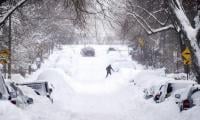‘Rapid, unchecked construction destroying soil structure’
KarachiWith 13 lives, seven among them children, having been lost to what experts termed a consequence of rapid disintegration of soil structure caused by unmitigated and careless construction in and around the brittle hills of Gulistan-e-Jauhar, the city's commissioner spared little time in imposing a ban on any type of
By Tehmina Qureshi
October 14, 2015
Karachi
With 13 lives, seven among them children, having been lost to what experts termed a consequence of rapid disintegration of soil structure caused by unmitigated and careless construction in and around the brittle hills of Gulistan-e-Jauhar, the city's commissioner spared little time in imposing a ban on any type of construction around hilly areas, a step that local authorities seem to believe could prevent similar incidents in the future.
However, there remains little to suggest that Shoaib Ahmed Siddiqui's knee-jerk reaction could prove enough in terms of providing a long-term solution to the plethora of development problems prevalent in Karachi.
A visit to the plot where nine members of one family and four others of another family died in their sleep on Tuesday night revealed as much.
The rock face from where a part fell down on the slumbering family, has caved inwards, while concrete houses and similar shanty settlements punctuate the entire length of the pale rocky hill, the other side of which faces the NED and Karachi universities.
The brittle rock face — made up of rough horizontal layers of shale, sandstone and limestone — used to resemble a hill till the mid 1990s when it was eroded by landowners to expand the plots situated right next to it. According to a former director of the Karachi Development Authority’s (KDA) enforcement wing, Jameel Baloch, the plot where the tragedy occurred and others alongside it were allotted in 1995 after which they were regularised by the KDA. “At that time, the hill used to have somewhat of a 45 degree slope. The plots were initially covering 500 square yards. However, the owners began cutting into the face of the hill to expand the area of their plots, damaging the hill's structure,” he said.
“The 45 degree slope of the hill, consequently, came to a complete right-angle and the natural face of the hill was destroyed.”
A professor of KU’s geology department who is also a resident of the vicinity where the tragedy occurred, Prof Masood Ahmed, concurred with Baloch's views. Visiting the site after the tragedy, he said the slope of a hill gives some stability to the brittle rocks which turn to clay-like substance and firm up at the bottom of the slope.
However, this face of the rock is not even 90 degrees, most of it is caved inwards due to the rampant construction along its sides. “Moreover, the Gulistan-e-Jauhar area is situated on a fault line. I have been telling people of the area not to build their houses around the hill because it is dangerous,” he said.
Dr Noman Ahmed, the chairman of NED’s department of architecture, while elaborating on the incident said the disintegration of natural soil strata in the area was giving rise to such tragedies, particularly in this area.
According to him, topographically, the terrain in Gulistan-e-Jauhar was a mixture of rocky and porous soil. Similarly, he said, the development too was uneven, with pockets of slum and concrete settlements at every short distance.
He said the rapid construction did have a role to play in generating man-made tragedies like this since construction over the top of the hill and around it required the use of heavy machinery on the brittle rocks. The reverberations caused by heavy machinery stay inside the brittle rock and then, suddenly, cause pieces to fall off.
Explaining this phenomenon, the former chairman of KU's geology department, Dr Majeedullah Qadri, said the rock comprised of horizontal layers of shale and sandstone, which were brittle, with some smattering of hard limestone.
“But the layers are not well bedded in each other,” he said. “Now there are a large number of houses built around the rock face where water is used up for sanitation and gardening purposes. The shale stone is brittle and comprises of clay minerals and they absorb water, while the limestone makes up the harder layers of the rock. So the combined effect of construction and seepage of water cause the clay minerals in the shale stone to expand and become slippery, also increasing in weight. Thus, if there happens to be a weak spot somewhere along the rock face, it falls off.”
Dr Qadri recommended leaving a space of at least 10 to 15 feet from the side of the rocks such as those in Gulistan-e-Jauhar. “A large number of houses have been built right next to the brittle rock face and they are in extreme danger,” he said.
According to the notification issued by the city commissioner on Tuesday, no building plan will be approved by the authorities for construction around any hill in the city. Another aspect being considered by the authorities is of China-cutting, but that too translates into the problem of thoughtless development on the ground.
Perhaps the report of the four-member committee set up to probe the matter will reveal more when its report, due to be released on Wednesday (today), surfaces.
However, Dr Noman Ahmed remarked that it was time the government and planning authorities stopped coming up with such knee-jerk reactions. “The problem is that we only respond to tragedies. To really resolve the city's development issues, we need a much more holistic solution for town planning while keeping the relevant by-laws and regulations in mind. A simple ban is not enough.”
With 13 lives, seven among them children, having been lost to what experts termed a consequence of rapid disintegration of soil structure caused by unmitigated and careless construction in and around the brittle hills of Gulistan-e-Jauhar, the city's commissioner spared little time in imposing a ban on any type of construction around hilly areas, a step that local authorities seem to believe could prevent similar incidents in the future.
However, there remains little to suggest that Shoaib Ahmed Siddiqui's knee-jerk reaction could prove enough in terms of providing a long-term solution to the plethora of development problems prevalent in Karachi.
A visit to the plot where nine members of one family and four others of another family died in their sleep on Tuesday night revealed as much.
The rock face from where a part fell down on the slumbering family, has caved inwards, while concrete houses and similar shanty settlements punctuate the entire length of the pale rocky hill, the other side of which faces the NED and Karachi universities.
The brittle rock face — made up of rough horizontal layers of shale, sandstone and limestone — used to resemble a hill till the mid 1990s when it was eroded by landowners to expand the plots situated right next to it. According to a former director of the Karachi Development Authority’s (KDA) enforcement wing, Jameel Baloch, the plot where the tragedy occurred and others alongside it were allotted in 1995 after which they were regularised by the KDA. “At that time, the hill used to have somewhat of a 45 degree slope. The plots were initially covering 500 square yards. However, the owners began cutting into the face of the hill to expand the area of their plots, damaging the hill's structure,” he said.
“The 45 degree slope of the hill, consequently, came to a complete right-angle and the natural face of the hill was destroyed.”
A professor of KU’s geology department who is also a resident of the vicinity where the tragedy occurred, Prof Masood Ahmed, concurred with Baloch's views. Visiting the site after the tragedy, he said the slope of a hill gives some stability to the brittle rocks which turn to clay-like substance and firm up at the bottom of the slope.
However, this face of the rock is not even 90 degrees, most of it is caved inwards due to the rampant construction along its sides. “Moreover, the Gulistan-e-Jauhar area is situated on a fault line. I have been telling people of the area not to build their houses around the hill because it is dangerous,” he said.
Dr Noman Ahmed, the chairman of NED’s department of architecture, while elaborating on the incident said the disintegration of natural soil strata in the area was giving rise to such tragedies, particularly in this area.
According to him, topographically, the terrain in Gulistan-e-Jauhar was a mixture of rocky and porous soil. Similarly, he said, the development too was uneven, with pockets of slum and concrete settlements at every short distance.
He said the rapid construction did have a role to play in generating man-made tragedies like this since construction over the top of the hill and around it required the use of heavy machinery on the brittle rocks. The reverberations caused by heavy machinery stay inside the brittle rock and then, suddenly, cause pieces to fall off.
Explaining this phenomenon, the former chairman of KU's geology department, Dr Majeedullah Qadri, said the rock comprised of horizontal layers of shale and sandstone, which were brittle, with some smattering of hard limestone.
“But the layers are not well bedded in each other,” he said. “Now there are a large number of houses built around the rock face where water is used up for sanitation and gardening purposes. The shale stone is brittle and comprises of clay minerals and they absorb water, while the limestone makes up the harder layers of the rock. So the combined effect of construction and seepage of water cause the clay minerals in the shale stone to expand and become slippery, also increasing in weight. Thus, if there happens to be a weak spot somewhere along the rock face, it falls off.”
Dr Qadri recommended leaving a space of at least 10 to 15 feet from the side of the rocks such as those in Gulistan-e-Jauhar. “A large number of houses have been built right next to the brittle rock face and they are in extreme danger,” he said.
According to the notification issued by the city commissioner on Tuesday, no building plan will be approved by the authorities for construction around any hill in the city. Another aspect being considered by the authorities is of China-cutting, but that too translates into the problem of thoughtless development on the ground.
Perhaps the report of the four-member committee set up to probe the matter will reveal more when its report, due to be released on Wednesday (today), surfaces.
However, Dr Noman Ahmed remarked that it was time the government and planning authorities stopped coming up with such knee-jerk reactions. “The problem is that we only respond to tragedies. To really resolve the city's development issues, we need a much more holistic solution for town planning while keeping the relevant by-laws and regulations in mind. A simple ban is not enough.”
-
 Former Nickelodeon Star Kianna Underwood Dies At 33 In Tragic Hit-and-run
Former Nickelodeon Star Kianna Underwood Dies At 33 In Tragic Hit-and-run -
 Prince Harry Risks Straining Marriage To Make Archie, Lilibet Make Emotional Demand Of Meghan
Prince Harry Risks Straining Marriage To Make Archie, Lilibet Make Emotional Demand Of Meghan -
 Sarah Ferguson’s Pal Reveals What She Really Thinks Of Beatrice, Eugenie Choosing A Royal Christmas
Sarah Ferguson’s Pal Reveals What She Really Thinks Of Beatrice, Eugenie Choosing A Royal Christmas -
 North West Raps About Piercings, Tattoos And Skipping School In New Song
North West Raps About Piercings, Tattoos And Skipping School In New Song -
 Teddi Mellencamp Shares Hopeful Health Update Amid Cancer Battle: 'Cloud Is Lifting'
Teddi Mellencamp Shares Hopeful Health Update Amid Cancer Battle: 'Cloud Is Lifting' -
 Prince William Makes Clear The Conditions He Has For Meeting Prince Harry
Prince William Makes Clear The Conditions He Has For Meeting Prince Harry -
 Sara Foster Slams Age Gap Relationship After 'blah' George Clooney Date
Sara Foster Slams Age Gap Relationship After 'blah' George Clooney Date -
 Jennifer Garner Recalls Enduring Ben Affleck’s Intense Beyoncé ‘Halo’ Phase
Jennifer Garner Recalls Enduring Ben Affleck’s Intense Beyoncé ‘Halo’ Phase -
 Prince Harry’s Mental Health Ends Up At Stake As Meghan Moves Him To 'second Fiddle'
Prince Harry’s Mental Health Ends Up At Stake As Meghan Moves Him To 'second Fiddle' -
 Bradley Cooper On Who His Mother Thinks Is The World’s Best Actor
Bradley Cooper On Who His Mother Thinks Is The World’s Best Actor -
 Meghan Markle Offers Glimpse Into Intimate Dance Moment With Harry Amid Split Rumors
Meghan Markle Offers Glimpse Into Intimate Dance Moment With Harry Amid Split Rumors -
 Jon Bon Jovi Joins The Viral 2016 Throwback Trend With Nostalgic Photos
Jon Bon Jovi Joins The Viral 2016 Throwback Trend With Nostalgic Photos -
 Kate Middleton Hailed For Her Lack Of ‘obligation’ As Well As Altruistic, Selfless Qualities
Kate Middleton Hailed For Her Lack Of ‘obligation’ As Well As Altruistic, Selfless Qualities -
 Jason Momoa Says Being With Beau Adria Arjona Feels 'perfect'
Jason Momoa Says Being With Beau Adria Arjona Feels 'perfect' -
 Idris Elba Says One Mix-up Nearly Cost Him A Knighthood From King Charles
Idris Elba Says One Mix-up Nearly Cost Him A Knighthood From King Charles -
 Andrew Mountbatten Windsor Incurs Anger Of Biggest Royal
Andrew Mountbatten Windsor Incurs Anger Of Biggest Royal



